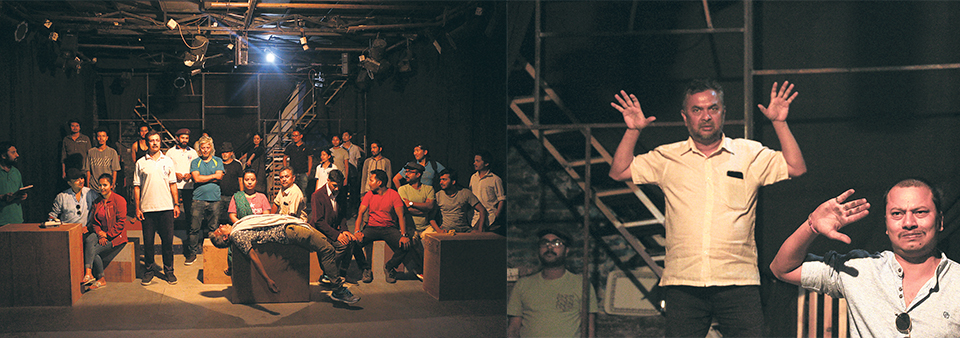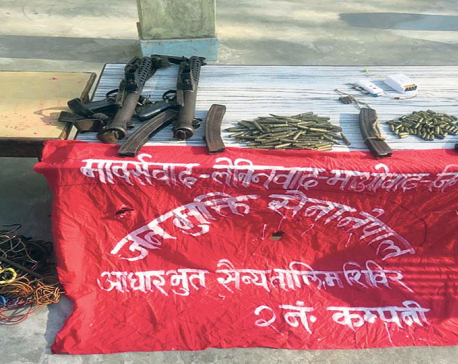
OR

The play starts out with a narration done by the corpse of a character called Isheshwor who tells the story leading to his death to the audience. The story is based in a fictional village called Sitapur that is meant to be representative of villages in South Asia in general.
Maha Bhoj, a new play that will be showcased at Mandala Theater in Anamnagar, Kathmandu, from Saturday, August 31, was written more than four decades ago by Indian author Mannu Bhandari. Anup Baral, director of the play, says that although the play is quite dated, its context and plot can still draw parallels with the political scene of Nepal and a lot of other South Asian nations in general.
This is the first play that Baral, who is also the director of Actors’ Studio Nepal, has directed in two years. Nepali poet and songwriter Viplob Pratik translated the play into Nepali. Pratik says that he took some creative liberty to restructure the story written by Bhandari so that the plot can be more relatable for Nepali viewers.
The play starts out with a narration done by the corpse of a character called Isheshwor who tells the story leading to his death to the audience. The story is based in a fictional village called Sitapur that is meant to be representative of villages in South Asia in general. As Isheshwor’s story moves forward, we see how powerful political leaders and police are all hiding things and manipulating the villagers to gain personal favor and power.
“This case of Isheshwor’s death and the mysteries surrounding it resemble similar cases that occur very often in Nepal like the rape and murder case of Nirmala. So I think watching this play right now will give the audience a lot to ponder on,” says Baral who believes plays with political messages can be powerful.
Even though Baral emphasizes the fact that the play feels relatable, he also confesses that he has tried his best to structure the progression of the play in a way that anytime the audience gets attached to the storyline and starts empathizing deeply with the characters, they are immediately made aware of the fact that the story is fictional. This is also the reason why the play is narrated by a corpse, which is a deviation from the original story written by Bhandari where a scholar researching the case of Isheshwor’s death is the narrator. Baral reveals that he is doing this so that viewers can analyze the plot objectively without forming any emotional connections with the characters that might make them biased in one way or the other.
Sometimes it’s the music that breaks away the emotional progression of the play to bring about a playful and fun atmosphere that acts as a barrier to separate the emotions of the audience from the play. In other instances the music is actually used as a device to further the story – it narrates the parts of the story that can’t be actually shown in the play.
Maha Bhoj utilizes both pre-recorded tracks as well live music. Musician Utsav Budhathoki composed and arranged the music while Pratik wrote the lyrics for the songs. Baral mentions that Maha Bhoj follows the format of an epic play and the audience can also identify this because of the chorus chanting – common in epic plays – that come in time and again during its two-hour runtime.
As is the norm for all plays directed by Baral, Maha Bhoj boasts an impressive cast of almost 30 individuals that includes acting veterans like Ramesh Budhathoki, Bijay Baral and Som Nath Khanal as well as some fresh faces in the theater scene. Baral mentions that even though a lot of times young actors disguised underneath layers of makeup and wigs play elder characters these days, he wanted actors who are close to the age of the character they are portraying because that way they can deliver the emotions and empathize with their characters better. The cast also includes the likes of Dayahang Rai, Rajesh Hamal, Buddhi Tamang, and Pratik.
The play has a total of 11 scenes that have been structured as story chapters and the narrator starts each scene by naming the chapter titles first. At times, as the scenes progress, it’s the character themselves that subtly change the set design in front of the audience without making it too obvious. The play has utilized minimalistic props that mostly include furniture. Lights and sounds are also used in fascinating ways in Maha Bhoj. In a scene where one of the characters is imprisoned, the light is manipulated to create an illusion of cell bars out of shadows.
Because he feels plays are actually an art form, Baral states that he can’t really speculate how the viewers will take to it. However, what he knows for sure is that, since most of the scenes are quite obvious regarding their message and symbolism, the audience will be able to grasp the storyline fairly easily and understand its different implications.
You May Like This

Amazon confirms two employees in Italy have contracted coronavirus
WASHINGTON, March 2: Amazon.com Inc said late on Sunday that two employees in Milan, Italy, have contracted the coronavirus and... Read More...

Smugglers’ go-downs near customs office
SIRAHA, March 16: On March 10, a team from the District Police Office (DPO), Siraha, arrested a truck with an... Read More...

Govt restricts Chand group’s activities
KATHMANDU, March 13: The government on Tuesday outlawed the ‘political activities’ of the semi-underground Communist Party of Nepal led by... Read More...





Just In
- MoHP cautions docs working in govt hospitals not to work in private ones
- Over 400,000 tourists visited Mustang by road last year
- 19 hydropower projects to be showcased at investment summit
- Global oil and gold prices surge as Israel retaliates against Iran
- Sajha Yatayat cancels CEO appointment process for lack of candidates
- Govt padlocks Nepal Scouts’ property illegally occupied by NC lawmaker Deepak Khadka
- FWEAN meets with President Paudel to solicit support for women entrepreneurship
- Koshi provincial assembly passes resolution motion calling for special session by majority votes






_20220508065243.jpg)






Leave A Comment